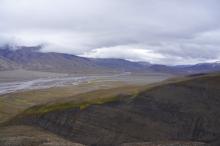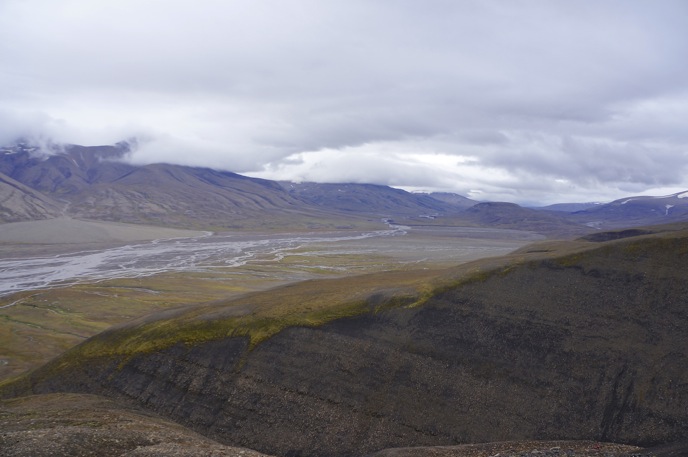Not exactly a plant hunting excursion but a nice trip anyway.
Last time it was vacation, very fine weather and flowering plants all places, this time it was work, cloudy and the fall had arrived; but interesting anyway.
We didn't go far from Longyearbyen either but had to bring guns anyway. (My daughter who is a student up there now told me she has to bring a gun every time she is going to pee behind a boulder when she is out in the fields!)
Adventdalen (The Advent Valley) in fall colour. Adventelva (The Advent River)
This German plane is from WW2. Adventfjorden (The Advent Fiord)
Hjortfjellet and Operafjellet (fjellet = the mountain). The EISCAT radar used to study interactions between the Sun and the Earth.
Breinosa, at about 600m it isn't many plants. The rocks are part of a vast block field. Up here only mosses and lichens grow (and the Svalbard poppy).



Comments
Trond Hoy
A yellow lichen at Breinosa.
Tue, 09/03/2013 - 1:36pmA yellow lichen at Breinosa. View from Breinosa - Scott Turner breen (glacier).
Eriophorum scheuchzeri ssp arcticum and Saxifraga cespitosa in seed.
8000 years ago the valley was an arm of the fiord. The old beach is deposited at about 54 m ASL. Later a glacier covered the beach with a moraine and glaciofluvial deposits.
Animals living in and on the beach was killed. This clam, Mya truncata, still contained organic material and the siphon is freeze dried.
Richard T. Rodich
Wow, I had no idea a siphon
Tue, 09/03/2013 - 6:04pmWow, I had no idea a siphon could be so long! But, I have only seen them on the freshwater mussels here in Minnesota.
Amazing that it could be preserved so well.
In the pic with the man(?) kneeling with the Eriophorum, is that ground dry enough to not get your knees all wet? Maybe he's wearing waterproof pants?
Lori S. (not verified)
Magnificent, barren scenery,
Tue, 09/03/2013 - 9:39pmMagnificent, barren scenery, Trond, and what fabulous colours in the close-ups! Looks like a really special trip - thanks for showing us the photos.
Trond Hoy
RickR wrote:
Wed, 09/04/2013 - 3:37am[quote=RickR]
Wow, I had no idea a siphon could be so long! But, I have only seen them on the freshwater mussels here in Minnesota.
Amazing that it could be preserved so well.
In the pic with the man(?) kneeling with the Eriophorum, is that ground dry enough to not get your knees all wet? Maybe he's wearing waterproof pants?
[/quote]
The siphon can be up to about 15cm and the clam can bury itself down to 30cm. The very dry and cold climate preserve organic matter for centuries!
The area where the man is kneeling is part of a patterned ground (similar to that shown by Lori but here it is saturated with water). In this case the polygons are rather firm but the boundaries are filled with water that freezes in winter. These freezing - thawing cycles produce something called ice wedging which make the ditches (and the stone rings and polygons).
So, yes, the ground is firm enough and usually not very wet but the ditches are wet and deep. The water doesn't drain because the ground is still frozen under about 1m deep.
Lori, it is barren but at the same time it is rather green (in summer). You will find plants (including mosses and lichens) almost everywhere. It is also animals, from polar bears (not often seen in summer), reindeer and insects etc of course. And not to forget birds, thousands of them although many leave in winter.
Trond Hoy
We investigated Longyearbreen
Wed, 09/04/2013 - 4:16amWe investigated Longyearbreen (-glacier) which has receded several hundred meters in about 100 years.
The left picture shows the terminal moraine in 1936, and the right picture shows the lateral moraine in the same year.
Left pic: The white clad person stands where the glacier reached in 2004, the blue clad person where the glacier was in 1990. You can see the limit of the ice where it was in 1936 in the upper left corner. The right pic shows the dead ice slowly melting.
It is a lot of debris on the ice and meltwater dig streambeds in the ice.
View of Longyeardalen (-valley). The debris is full of fossils particularly of plants form early tertiary woods. The conifer is Metasequoia occidentalis. Metasequoia, Taxodium and Larix are adapted to midnight sun and winter darkness (they are deciduous).
Richard T. Rodich
Thanks, Trond. Geology is so
Wed, 09/04/2013 - 9:47amThanks, Trond. Geology is so interesting (especially when you have no clue!).
What is "dead ice"?
I can only guess....
Trond Hoy
Thanks Rick.
Wed, 09/04/2013 - 12:05pmThanks Rick.
What's your guess of "dead ice"?
Dead ice is when a glacier (or pieces of it) stop moving and melt where it is. Huge amounts of ice can be concealed inside the moraine where it slowly melts. This makes the ground very hummocky with pits and depressions.
In fact, many polar glaciers are cold (cold based) which means they are frozen to the underground and rarely moves at all (but it is movements inside the ice and debris is transported downwards).
On Svalbard the glaciers are polar or semi polar (polythermal). The last ones are frozen to the bedrock only at the edges (you know, the melting point of ice decrease with the pressure). On the mainland of Norway almost all glaciers are warm based (the ice is above the melting point where it is in contact with the bedrock) and moving. This kind of glaciers do a lot of eroding.
Richard T. Rodich
Hoy wrote:
Wed, 09/04/2013 - 3:21pm[quote=Hoy]
Thanks Rick.
What's your guess of "dead ice"?
[/quote]
I was thinking a detached and stagnant part of the glacier or a perhaps the remnant of a glacier. One might have thought I had it right, but I didn't understand the gravity <grin> of it, at all.
Thanks for explaining so clearly.
cohan (not verified)
Fantastic place at any time,
Wed, 09/18/2013 - 11:59pmFantastic place at any time, it seems- I've even seen photos of Longeyarbyen in winter looking very beautiful, though I'm not sure I'd visit then ;)